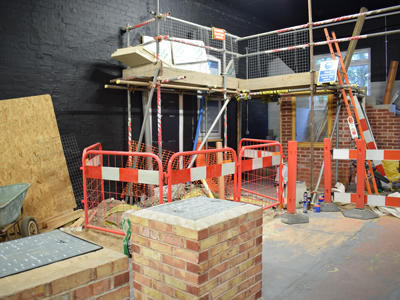Warning Zone: a safety educational experience like no other
Monday, 4 March 2019
“At the end of the day, I always say to the children: if you take one thing from Warning Zone, make it that little voice in your head that’s telling you to take the safe option.”

It's an idea that will resonate with any health and safety professional who has spent time persuading others to make the right choice, whether it’s to wear PPE, check their equipment or stick to the designated walk way: listen to the voice in your head that’s telling you not to cut corners or take unnecessary risks. For Richard Grudgings, Operations and Fundraising Manager for interactive Life Skills Centre Warning Zone, it’s the most important message children can take home.
Safety professionals have long argued that if we are to make further inroads into reducing workplace accidents and ill health, then risk education needs to begin at school. Warning Zone fulfils just that function, teaching children risk assessment and risk management skills, and emphasising individual responsibility, in an engaging and creative way.
Warning Zone is a unique, fully interactive learning experience for primary school children in Year 6; that is, 10 and 11-year-olds. The narrow target audience is deliberate, explains Richard, for two reasons. Firstly, the age of criminal responsibility is 10, so it is a logical age at which to discuss risk and responsibility. Secondly, children in Year 6 are about to transition to secondary school: a time when they will naturally have more freedom and a greater variety of choices about how they behave and factors such as peer pressure really come into play. “We’re catching them at just the right age,” Richard confirms, “and it’s a great age to work with: every day is different.”
“Our key message is ‘How to stay safe on- and off-line’,” Richard explains. School-group visits last a full day, with children spending half a day in the innovative fairground-inspired online safety zone, and half a day exploring the other eight zones.
Each zone has a different theme and, uniquely among other life-skills centres around the country, each of the zones has its own separate room. Children spend 12 minutes in each of the eight zones:
- Fire risk in the home – looks at the common causes of fires, smoke detectors and fire escape plans.
- Electricity and building sites – considers the dangers of overhead cables and trespassing on construction sites.
- Alcohol – explains the impacts and dangers that can result from alcohol use.
- Personal safety - includes the difference between taking a risk and being in an unsafe situation and reducing and avoiding risks and Knife Crime Awareness.
- Water – explains flags at the beach, the dangers of rivers, lakes, reservoirs and canals and knowing what to do in emergencies. It also focuses on the danger of Quarries.
- Arson - covers resisting peer pressure and the age of criminal responsibility.
- Road safety – includes planning safe walking and cycling routes; behaviour near roads and Be Safe, Be Seen.
- Railways – looks at understanding the speeds at which trains travel and the distance it takes them to stop; trespassing; and behaviour near railway lines.

“We tell children at the start of the day that no pens or paper are required,” says Richard, “and they absolutely love it.”
Each room has a realistic setting, interactive equipment and special effects, and it’s very hands-on. In the electricity and building zone, for example, a child is asked to rescue a frisbee that has come into contact with an overhead line and there’s a big flash and a bang as they try to retrieve it. On the construction site there are pits, trenches, water sound effects and moving parts.
In the personal safety zone, children are presented with a scenario in which they get a call from their mum to say they’re late home, and they must decide whether to take the safe route – on a road with shops – or the alleyway, where “all sorts of things jump out at them – we try our best to scare them!” Afterwards, the children and their Warning Zone guide discuss how taking the unsafe route made them feel: racing heart, hairs standing on the back of the neck, and the all-important little voice inside their head telling them the alley isn’t safe.
The e-safety zone is no less innovative in its approach. Set out as a retro fairground, each stall explores a different aspect of online safety. There’s a grooming “Guess Who?” game where it turns out that the volunteer leading the game has lied; “The point is to demonstrate that anyone you meet online could be lying to you about who they are,” says Richard.
There’s also a coconut shy to educate children about cyber-bullying and the need to remember that real people are on the receiving end. The coconuts represent different gadgets, such as laptops and mobiles, and the children throw insults at them, before they are turned around to reveal a face on the other side.
For the future, Richard’s aim is to keep Warning Zone relevant, “as the issues keep changing”. The latest addition to the personal safety zone is knife crime. “We’re always looking to develop and change the zones. The online risk landscape in particular is constantly evolving. To make sure we maintain Warning Zone’s relevance, we need to secure donations as we receive no statutory support.”
Richard is passionate about the benefits of the project: raising pupils’ awareness of risk and setting them on the right path for young adulthood by amplifying that all-important little voice in the head. And it’s the combination of a hands-on learning experience and knowledgeable volunteer guides that has the potential to improve risk awareness for everyone: as Richard concludes, “Having older and younger generations mixing together changes the lives of both for the better.”
About Warning Zone
Starting off in a park in the half-term holidays, its popularity saw it move to rented warehouse premises for a time before it opened in its current, permanent home in 2012 after an 18-month renovation that saw the building being completely gutted. Warning Zone has more than 70 volunteer guides who come from a wide variety of backgrounds: from teachers to police, business leaders to students from the local universities, De Montfort and University of Leicester and colleges such as Loughborough, Leicester and WQE. As a charity, Warning Zone relies on donations to operate. They charge school parties £10 per head to visit, but the actual cost is £22. The shortfall must be made up through fundraising and donations, as the charity isn’t eligible for Lottery funding and receives no statutory support. Current sponsors include Leicestershire Fire and Rescue Service, Leicestershire Police, Next and Everards, Bray & Bray and Pochin, but there is always room for more! For more information about Warning Zone, visit: |

 Based in NEBOSH’s home city of Leicester, Warning Zone is a unique, fully interactive learning experience for primary school children in Year 6; that is, 10 and 11-year-olds. It evolved out of the crime-prevention initiative “Leicestershire and Rutland Crimebeat”. The initial concept – which remains unchanged – was to create interactive zones focusing on different aspects of safety.
Based in NEBOSH’s home city of Leicester, Warning Zone is a unique, fully interactive learning experience for primary school children in Year 6; that is, 10 and 11-year-olds. It evolved out of the crime-prevention initiative “Leicestershire and Rutland Crimebeat”. The initial concept – which remains unchanged – was to create interactive zones focusing on different aspects of safety.